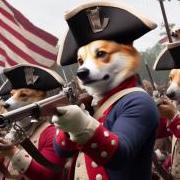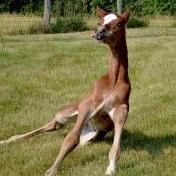
Davm
Members-
Posts
165 -
Joined
-
Last visited
Recent Profile Visitors
3,899 profile views
Davm's Achievements

Member (2/4)
-
Thanks. I've been trying to pick up some details on "Being a Cowboy" and there really isn't that much information. Until I read about the roping and cutting saddles I thought the only issue was the slope on back of the horse matching the saddle you got for it. I've been told a mule is built different and needs a different saddle. I've only rode a mule once. It was sort of a jarring ride but I wanted to adjust the stirrups and the guy said to leave them alone so that didn't help. It seemed the mule I rode was not as ornery as I had worried about. I like horses better. To me, building a saddle has to be the ultimate of the leather worker's craft. Stirrups: it looks like there may be different ways to attach them. I thought there was an adjustable band running over the top of the saddle but it looks like there may be sort style of fender to which the stirrup is affixed.
-
I recently got a catalog on tack and they have roping saddles, cutting saddles, etc. What's the difference?
-
That's my thinking, buckles on the inside will catch on each other. The reason I asked is most leathers have a wide, decorative half and on the style with the buckle on this wide part- the wide part ends up on the outside of the boot- where you can see it. On the other style the wide part is on the inside of the boot- if that makes sense. What part of Wyoming? I still have land west of Douglas. Family from Lusk, Laramie. Evanston. Now I live in Florida. Much warmer, not so windy.
-
One style has the tongue part of the larger half and the buckle is on a short, smaller half. The other has the buckle attached to the larger half with the larger half having 2 slots through which the tongue (part of the smaller half) is threaded. For those that have tried both styles- which do you prefer? Is the buckle always on the outside of the boot regardless of style? Thanks.
-
Great work. I'm just getting started and I'm having some issues on beveling curved lines, especially tight curls. I have a large square beveler which is fine if I am on an outside curve but on inside curves I need something smaller (I think) I have been tilting the stamp and it works okay but was wondering what stamps you use for your work? On the muleshoe, I think I've got that, tilt on subsequent marks to have a smaller size. I've seen some bevelers for sale that instead on a straight up and down side are V shaped. Not sure where they would be used.
-
My first carved holster.
Davm replied to dikman's topic in Gun Holsters, Rifle Slings and Knife Sheathes
Well laugh :) if you must but this belt, it is the tapered end style, so the section with the bullet loops is about 2" wide and the buckle and tongue area 1 1/2" wide. I have drawn out flowers, leaves, scrolls etc. but there seems to be a lot of background area. The holster, I use rawhide lace which is a different color, then a border (stamped) and it is a double loop, so there are loops over the pouch area. In short, there is a lot going on so if the flowers, etc. aren't perfect, you can "sort of" get away with it. Besides you have a large area for the pattern. But on a belt, everything has to be stretched out in a long skinny line and I just don't like what I've come up with, I've redrawn a lot and I practice on scraps. I've searched the net and actually a lot of the carved belts in my opinion don't really look that good. BUT I'll go on going on. This is the best hobby I've ever undertaken, love it. -
My first carved holster.
Davm replied to dikman's topic in Gun Holsters, Rifle Slings and Knife Sheathes
Post a photo of the belt if possible. I'm working on a similar project and finished a double loop holster for a 4 3/4" gun. One fortunate thing, the loops cover some of the carving, so... between the loops and the border my "so-so" carving ended up looking better than I thought. The carving on the belt, that has been actually more difficult, I'm trying to come up with a pattern and have taken a little from various things I've seen and so far I am practicing sections on scrap pieces of leather. I have a problem with scrolls. The Tandy book has you use a camouflage stamp around the perimeter and you can get things "out of round" and then the background stamp sort of blends in- in any event re-thinking the pattern all the time. But having fun. -
Thanks. I already discovered that the temper of leather for a swivel knife is different than for the stamping I've done so I guess a lot of this is putting in the time. I am actually keeping notes of what I have done that looks okay or nor okay. Some of it is by pure accident, I'll look at something I've done and if it looks pretty good- I'll immediately write down what I just did so I don't forget how I did it. In any event, I'm having a lot of fun which is the whole thing if you are a newbie/hobbyist. One thing I've noticed is at first I had no idea what I was doing. Now I look at other examples of good carving and I can tell more what is being done and why it looks better. So...a certain amount of careful studying is worthwhile. I'll bet most newbies such as myself "overdo it". Too much stamping, decorative cuts, etc. in a haphazard manner when a careful analysis and making less marks but well made and well placed marks is at least one key. I'm learning that good carving considers a flow and that is very important.
-
I'll see if can figure out how. I am sort of behind the times on some computer stuff. Last night I practiced on some scraps and practiced on some scraps using the spoon end of the stylus and I did get a more rounded look. I also tried the bevel, then stamp in certain areas and that was a big improvement. The other thing I did, I was using the swivel knife to make all the cuts- still do that, but then did ALL the camouflage stamping for the whole works, then all the pear shading for the whole thing, etc. Last night I did just one small area until that was what I wanted and then moved over to the next area and that seemed to work better for me. In any event I realize it is okay to think outside the box. I practice a lot on scraps until it is about as good as I can do and then do an actual belt or holster.
-
Kseidel: I've been studying your work. I think I am overdoing it with too many decorative cuts, too much stamping. Like the girl that puts on too much make up. Probably most beginners do the same thing. Your work has less but looks 100% better. There is a 3d effect on the pear shading. On the darker tones- stamp deeper or burnish the area more or a little of both? Your stems have a rounded, natural effect and mine are flat with beveled edges. My leaves look the same, a flat leaf with pear shading on the inside and then a bevel around the perimeter of the leaf with a flat body. How do you get that rounded effect? Work the area with a stylus? I realize it takes years to develop your level of work. Once again, your work is outstanding?
-
Thanks on the lifter.
-
Beautiful work, A-1. Thanks on the beveling. The Tandy book, which I'm starting to l realize was for beginners, has it the other way but it didn't make sense. On pear shading, is it the same? The book had the stamp but if you stamp and then shade, the shade takes out some of the stamp mark. I saw a "you tube" where there was atool to sort of under cut the edge of a flower, etc. to make it stand out more. I think it might have been just for a particular part of a bend, curve, etc.
-
First, I've asked a lot of questions as a newbie so THANKS everyone for the help, really do appreciate it. You have to carve a few things, look at it, analyze it and ask yourself, "why doesn't this look as good as a lot of the other work I see?" One problem I am having is curved stems or scrolls. A camouflage stamp seems too much of an arc but the Tandy book says to use that stamp and angle it. The veiner seems similar but if used mostly for leaf veins? As a general rule, for a curved stem, how far across do you have the stamp mark and how far across the pear shading? Do you usually stamp the outside of the curve about half way across and pear shade the balance? Maybe every job is its own boss, there are no "rules". Thanks for any comments. Do you have a variety of veiner and camouflage so the tool matches the work? And, as I think about it, if you stamp the outside curve of the stem with a camouflage stamp an then bevel it, right now my beveling seems to be obliterating the camouflage stamp- to a degree.
-
Thanks- I'm going to buy an angled blade. The "regular" blade, on tight curves I have my eyes right now on the leather trying to follow the scribed lines and really having a problem so I think the angled will help a lot. It will help me follow the scribed line better.
-
I have a regular, steel swivel knife. I probably have to practice more than I have but small curves seem difficult to make. Is the angled swivel knife blade intended for small curves or something else? The other issue is, the cut needs a certain shape or width. Does the angled blade make this or is the cut subject to closing up? If I get an angled blade, the ceramic costs more but I am wondering how easy it is to sharpen an angled steel blade and keep the bevels okay. The ceramic blade sold by Tandy is steel colored but I am told it is ceramic and I never have to sharpen it, just strop. Comments appreciated.



